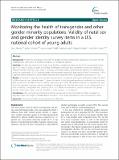Monitoring the health of transgender and other gender minority populations: Validity of natal sex and gender identity survey items in a U.S. national cohort of young adults

View/
Author
Reisner, Sari L
Conron, Kerith J
Tardiff, Laura Anatale
Jarvi, Stephanie
Austin, S Bryn
Published Version
https://doi.org/10.1186/1471-2458-14-1224Metadata
Show full item recordCitation
Reisner, Sari L, Kerith J Conron, Laura Anatale Tardiff, Stephanie Jarvi, Allegra R Gordon, and S Bryn Austin. 2014. “Monitoring the health of transgender and other gender minority populations: Validity of natal sex and gender identity survey items in a U.S. national cohort of young adults.” BMC Public Health 14 (1): 1224. doi:10.1186/1471-2458-14-1224. http://dx.doi.org/10.1186/1471-2458-14-1224.Abstract
Background: A barrier to monitoring the health of gender minority (transgender) populations is the lack of brief, validated tools with which to identify participants in surveillance systems. Methods: We used the Growing Up Today Study (GUTS), a prospective cohort study of U.S. young adults (mean age = 20.7 years in 2005), to assess the validity of self-report measures and implement a two-step method to measure gender minority status (step 1: assigned sex at birth, step 2: current gender identity). A mixed-methods study was conducted in 2013. Construct validity was evaluated in secondary data analysis of the 2010 wave (n = 7,831). Cognitive testing interviews of close-ended measures were conducted with a subsample of participants (n = 39). Results: Compared to cisgender (non-transgender) participants, transgender participants had higher levels of recalled childhood gender nonconformity age < 11 years and current socially assigned gender nonconformity and were more likely to have ever identified as not completely heterosexual (p < 0.001). No problems with item comprehension were found for cisgender or gender minority participants. Assigned sex at birth was interpreted as sex designated on a birth certificate; transgender was understood to be a difference between a person’s natal sex and gender identity. Participants were correctly classified as male, female, or transgender. Conclusions: The survey items performed well in this sample and are recommended for further evaluation in languages other than English and with diverse samples in terms of age, race/ethnicity, and socioeconomic status.Other Sources
http://www.ncbi.nlm.nih.gov/pmc/articles/PMC4289327/pdf/Terms of Use
This article is made available under the terms and conditions applicable to Other Posted Material, as set forth at http://nrs.harvard.edu/urn-3:HUL.InstRepos:dash.current.terms-of-use#LAACitable link to this page
http://nrs.harvard.edu/urn-3:HUL.InstRepos:13890627
Collections
- SPH Scholarly Articles [6362]
Contact administrator regarding this item (to report mistakes or request changes)


